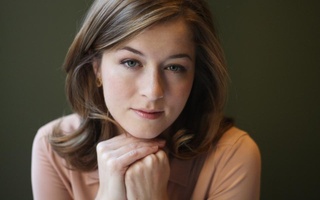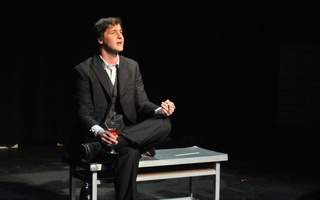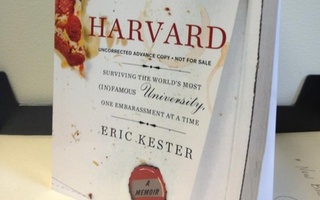Enda Walsh’s “Penelope” is not the first piece of Irish literature titled after a character who never speaks, nor is it the first to draw heavily from the works of Homer. Directed by Jacob A. Brandt ’14, this production, which runs from April 25 to May 3 on the Loeb Mainstage, gleefully collides the sublime with the ridiculous, transporting a mainstay of world literature to a banal, seedy modern-day setting. In the able hands of its four main actors, the Harvard-Radcliffe Dramatic Club’s production pulls off the play’s comic elements without passing over the sense of unease at the play’s heart.
Some 10 years after the fall of Troy, a scant four suitors remain prowling around the palace of Ithaca’s Penelope, fruitlessly attempting to win her affection. A prophecy foretelling the impending return of Odysseus––referred to throughout the play as merely “him,” a surprising amount of venom packed into one unassuming pronoun––drives them into a frenzy, and it isn’t long before their vows to work together fall by the wayside.
In this telling of Homer’s lofty epic, the suitors are confined to the bottom of a drained pool and clad in speedos and cheap-looking bathrobes (if there was ever a time to produce a play in the Adams Pool Theatre, this would have been it). The staging is a celebration of the tacky: Party City hats, Pepto-Bismol-pink mylar balloons, and spilled cheetos are among the decorative elements on show. This reimagining of the setting lends the play a claustrophobic feel; tension mounts as the four actors pace about the maddeningly cluttered pool bottom on which they live, attempting to lay claim to a piece of territory. All the same, these choices aren’t entirely original. Both the costuming (by Gina K. Hackett ’15, an active Crimson editor) and the set design (by Madelynne A. Hays ’13) cleave pretty closely to those of the play’s premiere at the Druid Theatre in Galway.
Walsh’s play is full of long, meandering speeches and sometimes bizarre dialogue (the phrase “sensuous ninja” makes an appearance); short on real plot, it takes dramatic chops to contour the play’s long actionless stretches and prevent it from feeling rudderless. As the sleazy lounge lizard Dunne, David A. Sheynberg ’16 manages to trace a believable and heartfelt emotional arc for his character, everting stasis and adding depth to what could easily have turned into a caricature. And in the roles of Quinn and Burns respectively, Ben J. Marek ’14 and Matthew J. Bialo ’15 inject the play with some much-needed energy and tension, Bialo in the form of a taut-lipped frown and an eerily intense gaze, and Marek in the form of a bulldogish aggression, his jaw tensed and his neck veins popping. Of the play’s central quartet of characters, the least compellingly portrayed is Fitz (Teis D. Jorgensen ’14). Though his climactic declaration of love for Penelope, which lures her out of seclusion for the first time in the suitors’ decade-long seige, is endearingly plain-spoken, his overall characterization falls short of the standards set by this successful scene. Easily the oldest man there, Fitz’s age and his habit of pill-popping are the butt of many jokes from his rivals in love, yet nothing about him, from his upright posture and high, unmodulated voice to his seemingly sober demeanor, is reflective of this. The only indication of his age is the makeup job.
An in-depth exploration of the performance of masculinity, “Penelope” offers viewers a compelling new take on Homer that is both unflattering and unflinching.
Read more in Arts
Prose ProsaicRecommended Articles
-
 Retelling Harvard
Retelling Harvard -
Wordplays"Wordplays" comes to the Adams Pool this week.
-
 Uneven Acting Stifles 'Wordplays'
Uneven Acting Stifles 'Wordplays' -
"punkplay" Rocks out in Adolescent WoeSensitive and insightful, "punkplay" details a misfit's quest for individualism.
-
 Which Books About Harvard Are Worth Reading?
Which Books About Harvard Are Worth Reading? -
“In the Dark” Lights Up with FearInspired by the “The Shining,” the Harvard-Radcliffe Dramatic Club production “In the Dark” seeks to explore violence on both a concrete and abstract level to illustrate how violent actions can simultaneously bring a family closer together and tear it apart.













